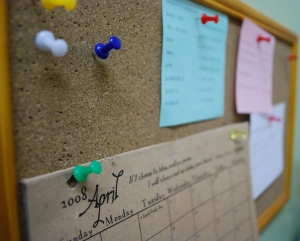The Mental Cork Board
A well-known technique for remembering arbitrary items through visual association is the method of loci (also known as “the journey method”):
[…] In this technique the subject memorizes the layout of some building, or the arrangement of shops on a street, or any geographical entity which is composed of a number of discrete loci. When desiring to remember a set of items the subject literally ‘walks’ through these loci and commits an item to each one by forming an image between the item and any distinguishing feature of that locus. Retrieval of items is achieved by ‘walking’ through the loci, allowing the latter to activate the desired items. […]
Even though the journey method is useful for remembering potentially long, ordered lists, I never really found much practical use for it in my everyday life. It’s a fun party game, but I think it takes too much preparation time to be useful in “real life” (probably only because I haven’t practiced it enough, but never mind that).
“To Do” Lists, Ideas, Thoughts and Random Notes
The canonical example of stuff we need to remember on a day-to-day basis is, of course, the (in)famous “to do” list. The list typically consists of an unordered collection of unrelated items with one or more actions associated with them. (Yeah, I know some people like to prioritize their “to do” list, but that’s usually just a symptom of the fact that they have too many items on it to begin with.) Another trait of the “to do” list is that its contents are highly volatile, typically changing from day to day, or even through the course of a single day. Also, once an item on the list is completed, remembering it typically no longer serves any purpose.
If you are a creative person you most likely also have other things you would like to remember, such as ideas, insights, decisions, random notes and other potentially interesting thoughts that may pop into your head during the day (or night). Of course, when possible, immediately persisting your thoughts is the best thing to do, but if that’s not an option, remembering them until you can is a good second.
Mental Notes
So, in order to remember everyday stuff like that, I came up with a very simple visualization technique I like to call “the mental cork board”. (I’m probably not the first person to come up with this technique, but I had never heard of it before, so I thought I would give it a try to see if it worked.) Here’s how it works:
In your mind, imagine an empty cork board hanging on a wall. As the board is initially empty, you can fill it up by pinning notes on to it, describing what you need to do or what you need to remember. For example, if you need to buy milk on your way home from work, imagine taking a physical paper note and writing down “buy milk” on it before you pin it up on the board. Need to fill gas on your car too? Write down “fill gas” on another note and stick it up there next to the first one. Now, as you drive off from work, you can easily recall the mental image of the cork board and read the notes that remind you to fill gas and buy milk on your way home.
If your visual memory is good (and if it isn’t, using this and similar techniques as exercises will hopefully improve it over time), you can add even more information to the notes by writing stuff on the back of them. Say that you needed to buy more than just milk in the grocery store. If so, you could write “buy groceries” on the note, then imagine flipping it around and writing out the shopping list on the back. Now, when you arrive at the store, simply imagine taking the note down from the board, flipping it around again and reading what’s written on the back.
Association with Physical Objects
If remembering text seems hard, don’t worry. You don’t have to limit the items to be paper notes or words. Why not hang other physical objects up there to remind you of whatever you need to do or remember? Say you need to deliver your car at the dealer’s for a service check. Just mentally hang your car keys on the board. Need to remember to pay a bill or post a letter? Pin it up there, and you will be reminded of it the next time you visualize the board in your mind. Need to remember a specific date, like someone’s birthday or an important event? Imagine a calendar hanging there and draw a red circle around the day. Need to buy oranges? Stick an orange up there. Whatever items will help you trigger the association and remember, put them up on the board.
Scaling Up
If you have a lot of stuff on your mind, the technique can also scale to include items of different topics. For example, you can keep separate mental boards for your personal and professional life or other projects you are involved in. When dealing with multiple boards it can be useful to distinguish them from each other by putting labels or signs above them, giving them different colors, or even putting them on different walls or in different rooms. Although it’s probably possible to extend this technique quite far, if you have so much stuff on your mind that you fill up more than three or four boards, I think it’s time to start writing things down…
